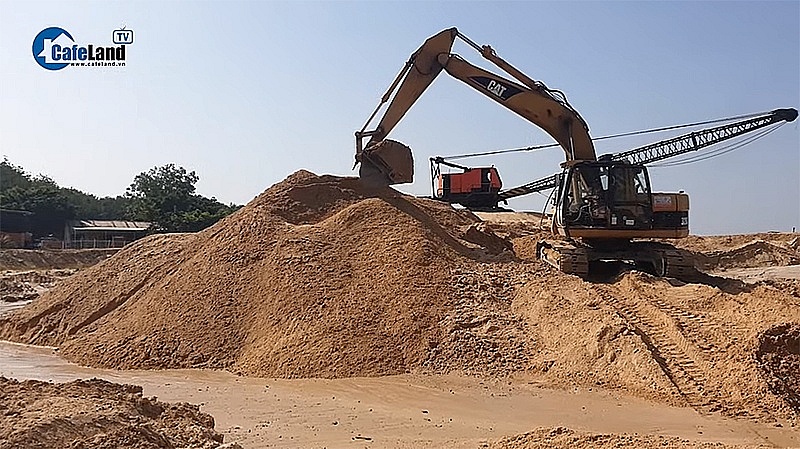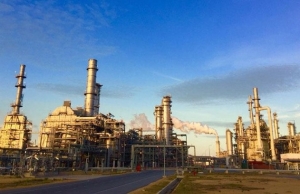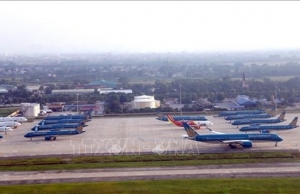Lack of sand prompts alternatives for traffic projects
Struggling with a serious sand shortage over the past several months, construction contractors of major transportation projects up and down Vietnam are seeking solutions.
 |
| Lack of sand prompts alternatives for traffic projects, photo Cafeland |
At the Tham Luong, Ben Cat, Nuoc Len canal project, in addition to tracking down legal sand sources, the contractor has been researching the reuse of excavated soil for on-site levelling and road foundations.
Trinh The Vu, representative of Saigon Traffic Construction JSC, said that good soil layers will be retained for leveling to replace sand.
“About half of the 3,000cu.m of excavated soil will be used for on-site levelling. Processes like soil quality testing and compaction testing are recorded and sent for inspection,” Vu said.
He added that replacing sand with qualified on-site soil gave quite positive initial results. “The samples are satisfactory. After testing, we will submit results to management for approval. If successful, we will use the soil at the project itself, reducing costs and speeding up the progress of the project,” Vu said.
Meanwhile, the Ministry of Industry and Trade is working with Cambodia on a plan to import sand for construction purposes (see Box). Earlier, TNT Group proposed to import sand from Cambodia as filling material for highway projects.
| At the end of March, the Vietnamese government issued a notification to ensure an adequate supply of materials for Ho Chi Minh City’s Ring Road 3 project, as well as and highway projects in the Mekong Delta region. The Ministry of Natural Resources and Environment immediately established an interdisciplinary working group led by a deputy minister, along with the participation of the ministries of transport, construction, and agriculture and rural development, to resolve the source of backfilling materials. The group will directly work with the southeast and southwest provinces to apply policies in the exploration and licensing of filling materials for key transportation projects in the south. Furthermore, this month, the Ministry of Transport (MoT) and relevant agencies will complete a plan for exploiting sea sand as filling material for expressway projects, which must clearly show the mining locations and usage addresses. The Ministry of Construction will soon announce the price of materials exploited at the mine. The MoT will collect, review, and re-evaluate the demand, supply capacity, and exploitation capacity of mines for levelling materials following the progress of each expressway project in the southern provinces, reporting to the prime minister. Meanwhile, the Ministry of Industry and Trade is working with Cambodia on a plan to import sand as a construction material. |
TNT Group is licensed by Cambodia to exploit sand on the Mekong River with reserves of about 30,000-50,000cu.m per day. Therefore, the enterprise is committed to meeting the needs of expressway projects in the Mekong Delta in terms of quantity, quality, and price.
TNT has asked the government to allow pilot import of sand to address shortages. “We need good mechanisms in terms of administrative procedures, transportation, and credit sources to import sand in large quantities,” a representative of TNT said.
In recent months, the third construction package for Ho Chi Minh City’s Ring Road 3 across Thu Duc had to be carried out in moderation because sand supply was limited.
This is a viaduct construction package, but the road must be reinforced and parallel roads built. Due to such obstacles, the contractor cannot carry out the work simultaneously even though the surface has been cleared.
Pham Dang Huyen, an engineer of the contractor consortium, said package 3 needed more than 200,000 cu.m of sand this year, and about 25,000 cu.m in April alone, but they were currently stuck.
“Numerous mines in the southern provinces have had to close, or priority has been given to local projects and the North-South Expressway, while some others have low reserves or have expired and wait for reissue procedures. Buying sand on the market is not easy because the materials for the projects need a clear origin and documentation in order to move forward,” Huyen said.
In the northwest of Ho Chi Minh City, package 8 for the ring road, through Hoc Mon district, is also struggling with a lack of sand. Hoang Phuc Thinh, head of a construction unit under CIENCO4 Group, said they required about 1.7 million cu.m of sand for the foundations, but since last August have only mustered a paltry 3,000 cu.m.
“The lack of sand makes construction difficult while we are handling ground treatment,” Thinh said.
“The average waiting time for road surface subsidence and loading is 12-16 months, so we need enough sand for the whole package at the start of May to complete all works in time.”
The lack of sand is an obstacle for all highway projects in the Mekong Delta region. The Can Tho-Ca Mau expressway started in January 2023 and has completed more than 20 per cent.
However, in the past few months, many bidding packages for the 110km works have been carried out in moderation. The project is six months behind schedule.
The 188-km Chau Doc, Can Tho, Soc Trang expressway construction scheme is also facing a serious sand shortage. The investor said that the project requires 31 million cu.m of sand, and eight million cu.m of this has yet to be sourced.
Sand reserves in the Mekong Delta provinces are still abundant, but sand mines are not allowed to exploit all the reserves because the sand is taken from upstream alluvium. Therefore, too much exploitation will impact flow and erosion, and cause a risk of landslides.
 | Billion-dollar projects removed from lineup of national investment projects One energy project and three automotive projects will be removed from the list of projects calling for foreign investment in 2021-2025. |
 | US supports Vietnam in air traffic management The Vietnam Air Traffic Management Corporation (VATM) and the United States Trade and Development Agency (USTDA) on September 11 signed a funding agreement on technical support on building advanced concepts of operations (ConOps) and functional requirements for air traffic management automation system and requirements of air traffic flow management system in Vietnam. |
What the stars mean:
★ Poor ★ ★ Promising ★★★ Good ★★★★ Very good ★★★★★ Exceptional
 Tag:
Tag:
Related Contents
Latest News
More News
- EVN launches major power infrastructure projects nationwide (December 19, 2025 | 18:17)
- VAL inaugurates second production line to meet domestic animal feed demand (December 19, 2025 | 16:37)
- Sun Group pioneers urban tram system in Phu Quoc (December 19, 2025 | 15:00)
- Seven major projects launched to drive Hanoi’s next growth phase (December 19, 2025 | 14:00)
- Securing capital and efficiency for Vietnam’s 2026-2030 growth ambitions (December 17, 2025 | 10:00)
- Vietnam bucking trend in the global M&A landscape (December 16, 2025 | 14:20)
- HDS Summit spotlights Vietnam’s rising role in regional supply chains (December 16, 2025 | 08:00)
- Kolon signs $48 million airbag supply deal with Autoliv (December 15, 2025 | 18:14)
- National Assembly approves Vinh–Thanh Thuy expressway project (December 15, 2025 | 18:02)
- Quang Tri green-lights $1.59 billion LNG-fired power project (December 15, 2025 | 17:59)























 Mobile Version
Mobile Version